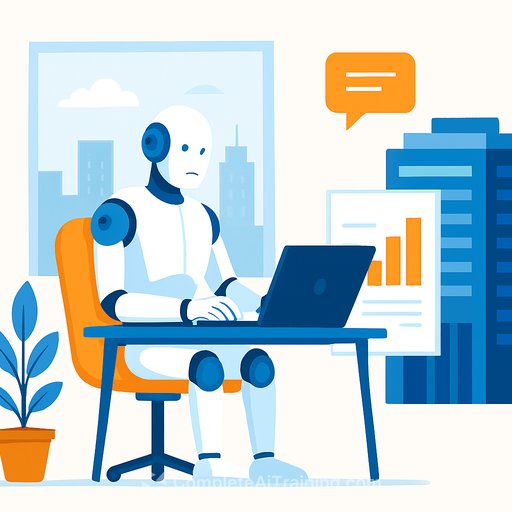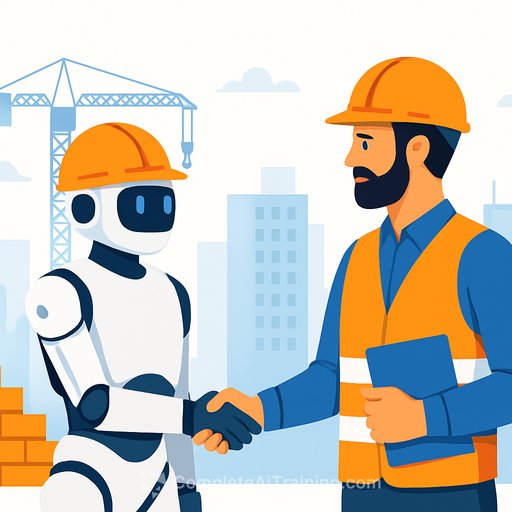Humanoids at Work: What It Means for Commercial Real Estate
Humanoid robots are moving from demos to pilots in warehouses, hospitals, hotels, and back-of-house retail. For owners, developers, and contractors, this isn't sci-fi. It's a new layer of building operations, risk, and leasing strategy.
Your advantage won't come from speculation. It will come from infrastructure, contracts, and workflows that let humans and robots share the same space without friction.
Where They Fit First
- Industrial and logistics: Loading docks, kitting, case picking, rework, and night-shift replenishment.
- Healthcare and senior living: Supply runs, room turnover support, pharmacy shuttles, and linen handling.
- Hospitality and retail: Back-of-house stock moves, room service delivery, after-hours restocking.
- Office and mixed-use: Mailroom, inventory, internal moves, security rounds, and facilities support.
Facility Design: Human + Robot
Most humanoids aim to use human spaces: doors, elevators, stairs, and tools. Small differences still matter. Consistent door hardware, predictable lighting, and clear floor edges reduce errors and downtime.
- Vertical movement: Elevator APIs, call buttons reachable at standard heights, safe entry/exit zones, and fallback access (ramps) where possible.
- Circulation: Service corridors with clean sightlines, mirrored corners, and marked passing zones. Avoid clutter in choke points.
- Floor loads and surfaces: Check live loads where fleets accumulate. Prefer non-glare, non-slip surfaces with low thresholds.
- Power and charging: 120/240V outlets at docking bays, battery-swap counters, and lockable charging rooms with ventilation.
- Connectivity: Building-wide Wi-Fi 6E plus private LTE/5G in service corridors, basements, and docks. Dead zones kill autonomy.
- Wayfinding: High-contrast markers at key decision points, consistent door labels, and machine-readable signage for delivery targets.
- APIs and access: Secure integrations with access control, elevators, fire panels, and BMS. No open ports. No shared passwords.
Safety, Code, and Insurance
Humanoids introduce moving mass, vision systems, and software risk into shared spaces. Require e-stops, geofencing, speed limits in public areas, and fail-safe behavior tied to fire alarms and access control.
Align with recognized guidance while local codes catch up. See OSHA's robotics resources and UL's guidance for service robots.
- OSHA: Robotics Safety
- UL: UL 3300 for Service Robots
- Insurance: Clarify GL, product liability, workers' comp for human-robot incidents, and cyber coverage for device compromise.
- Privacy: Define where cameras and mics are permitted, retention rules, and signage for areas under machine vision.
- After-hours ops: Program access routes that avoid residential stacks and public areas to reduce nuisance and risk.
Leasing: New Clauses You'll Need
- Permitted use and routes: Approved corridors, docks, and floors. No-go zones clearly mapped.
- Data rights: Who owns sensor maps, video, and performance logs. Allow operational data; restrict secondary use.
- Downtime and SLAs: Response times, spare parts availability, and penalties for repeated corridor blockages or elevator lockouts.
- Alterations: Charging bays, markers, door hardware, and elevator integrations classified as minor works with restoration terms.
- Comms and power: Minimum RSSI in service corridors, reserved SSIDs/VLANs, and dedicated circuits at docks.
- Indemnities: Clear lines among landlord, tenant, OEM, and integrator.
Economics and Underwriting
Expect two models: capital purchase or Robot-as-a-Service (monthly fee). RaaS shifts upfront cost to OpEx and moves risk to the vendor; CapEx gives control but adds maintenance obligations.
Underwrite with real numbers: task cycle time, path length, energy cost, elevator wait time, and human supervision minutes per hour. Savings often come from extended hours and fewer missed handoffs, not just labor line items.
Bonus value: cleaner back-of-house, tighter inventory control, and the ability to run nights without overtime. That can improve tenant margins and reduce churn.
Construction and Fit-Out Impacts
On jobsites, humanoids will assist with material moves, site scans, and repetitive install tasks. That means clearer pathways, charging areas, and a foreman who can assign machine-readable tasks.
For interiors, add device staging rooms, secured storage for spare parts, and QR-coded delivery targets at dock, closets, and suites. Treat robots like rolling equipment with software updates.
Connectivity and Digital Backbone
- Coverage plan: Heatmaps for Wi-Fi and private LTE/5G, including stairwells, basements, and elevators.
- Identity and security: Device certificates, network segmentation, and least-privilege access to building systems.
- Digital twin: Maintain up-to-date floor plans and BIM-derived maps. Robots fail on stale geometry.
Adoption Timeline (Practical View)
- 0-12 months: Pilots in logistics, hospitality, and healthcare back-of-house. Simple routes, supervised runs.
- 1-3 years: Multi-tenant use on defined service paths; routine elevator use; night operations become normal.
- 3-5 years: Wider code clarity, better insurance products, and portfolio-level contracts across assets.
Landlord Playbook: Start Small, Learn Fast
- Pick one building with cooperative tenants and clean back-of-house paths.
- List tasks suited to repeatable motion: dock-to-suite, trash runs, mail, stock.
- Run vendor trials on-site. Measure success with time-on-task and human minutes required.
- Audit connectivity and elevator integration. Fix dead zones before scaling.
- Update lease riders, insurance certificates, and incident protocols.
- Train security, facilities, and tenant reps on basic recovery steps and e-stops.
- Set KPIs: throughput, error rate, energy use, after-hours noise complaints.
What to Spec in New Developments
- Service corridors sized for two-way traffic with turning space at doors.
- Elevator interfaces with secure APIs and camera views at car and landing.
- Distributed power and charging near docks and on every service floor.
- Private LTE/5G plus Wi-Fi 6E with monitored uptime and latency.
- Machine-readable signage, consistent door hardware, and low-glare floors.
- Device management room with network termination, spares, and workbench.
Team Skills and Training
You'll need operators who can manage routes, recover faults, and read logs. Facilities teams will shift from "fix the cart" to "update the firmware and clear the path."
If you're building internal capability, map roles now: vendor manager, network lead, safety lead, and data analyst. For structured upskilling, see role-based AI and automation training options here: Complete AI Training - Courses by Job.
Bottom Line
Humanoids won't replace buildings. They will change how space performs, how leases read, and how teams work at 2 a.m. Owners who plan for routes, power, data, and liability will win the deals where automation lifts tenant margins-and NOI with them.
Your membership also unlocks:






